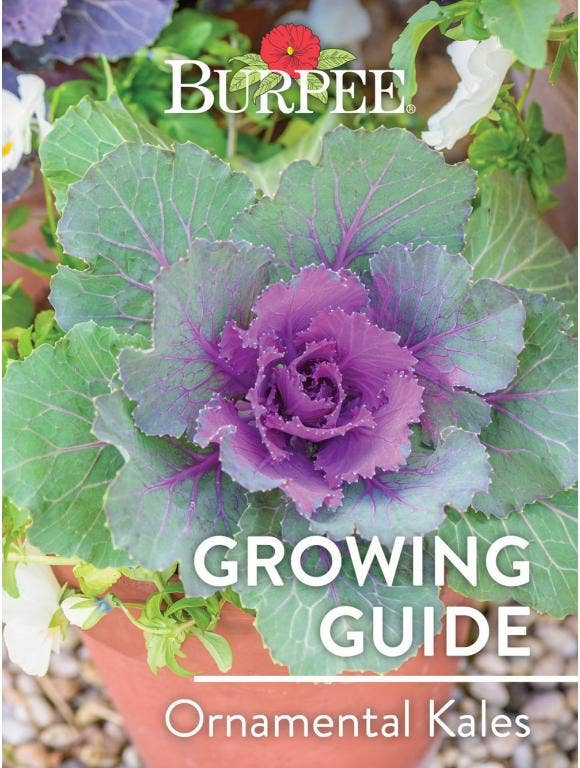
How to Sow and Plant
Planting from Transplants in Fall:
- Kale prefers a rich, well-drained soil, and can tolerate some shade. Avoid areas where any member of the cabbage family grew the year before. May also be planted in containers, including window boxes.
- Prepare the bed by turning the soil under to a depth of 8 inches. Level with a rake to remove clumps of grass and stones.
- Dig a hole for each plant large enough to amply accommodate the root ball. Space plants 1-1½ feet apart in rows 2 feet apart.
- Carefully remove the plant from its pot and gently loosen the root ball with your hands to encourage good root development.
- Place the top of the root ball even with the level of the surrounding soil. Fill with soil to the top of the root ball. Press soil down firmly with your hand.
- Use the plant tag as a location marker.
- Thoroughly water and apply a light mulch layer on top of the soil (1-2 inches) to conserve water and reduce weeds.
How to Grow
- Keep weeds under control during the growing season. Weeds compete with plants for water, space and nutrients, so control them by either cultivating often or use a mulch to prevent their seeds from germinating. Avoid disturbing the soil around the plants when weeding.
- Keep plants well watered during dry periods to promote rapid, uninterrupted growth.
- Monitor for pests and diseases. Check with your local Cooperative Extension Service for pest controls recommended for your area. While small, floating row covers will help to keep pests at bay.
Harvest and Preserving Tips
- The color of ornamental kale will intensify once the plants are exposed to frost.
- Ornamental kale can survive a light frost.
- Once the ground freezes its growing season is complete.
Common Disease Problems
Bacterial Leaf Spot: This causes brown water soaked spots on the foliage which eventually makes the foliage turn yellow. It thrives in cooler temperatures. Burpee Recommends: Remove infected plants. Rotate crops with plants in a different family. Avoid overhead watering. Do not work around plants when they are wet.
Downy Mildew: This fungus causes whitish gray patches on the undersides and eventually both sides of the leaves. Burpee Recommends: Rotate crops with plants in a different family. Avoid overhead watering. Provide adequate air circulation, do not overcrowd plants. Do not work around plants when they are wet.
Powdery Mildew: This fungus disease occurs on the top of the leaves in humid weather conditions. The leaves appear to have a whitish or greyish surface and may curl. Burpee Recommends: Avoid powdery mildew by providing good air circulation for the plants by good spacing and pruning. Contact your Cooperative Extension Service for fungicide recommendations.
Common Pest and Cultural Problems
Aphids: Greenish, red, black or peach colored sucking insects can spread disease as they feed on the undersides of leaves. They leave a sticky residue on foliage that attracts ants. Burpee Recommends: Introduce or attract natural predators into your garden such as lady beetles and wasps which feed on aphids. You can also wash them off with a strong spray, or use an insecticidal soap.
Flea Beetles: These small hopping beetles feed on plant foliage and can spread disease. Burpee Recommends: Rotate crops with plants in a different plant family. Use floating row covers to prevent damage to young foliage.
Leafminers: These insects bore just under the leaf surface causing irregular serpentine lines. The larvae are yellow cylindrical maggots and the adults are small black and yellow flies. They do not usually kill plants, but disfigure the foliage. Burpee Recommends: Remove affected foliage.
Slugs: These pests leave large holes in the foliage or eat leaves entirely. They leave a slime trail, feed at night and are mostly a problem in damp weather. Burpee Recommends: Hand pick, at night if possible. You can try attracting the slugs to traps either using cornmeal or beer. For a beer trap, dig a hole in the ground and place a large cup or bowl into the hole; use something that has steep sides so that the slugs can’t crawl back out when they’re finished. Fill the bowl about ¾ of the way full with beer, and let it sit overnight. In the morning, the bowl should be full of drowned slugs that can be dumped out for the birds to eat. For a cornmeal trap, put a tablespoon or two of cornmeal in a jar and put it on its side near the plants. Slugs are attracted to the scent but they cannot digest it and it will kill them. You can also try placing a barrier around your plants of diatomaceous earth or even coffee grounds. They cannot crawl over these.
FAQ
Can I grow ornamental kale in containers? Yes, but it performs best in larger containers. The plants are impressive in larger window boxes. Be sure to use a commercial container mix rather than garden soil.
Is ornamental kale edible? Yes, however the taste is bland and bitter and it has been selected for ornamental use rather than eating.
I have heard this plant called “flowering kale”. Does it bloom? No, the colorful foliage is called “flowering” because it looks like flowers.
Will ornamental kale come back in the spring? No, ornamental kale will be killed by a hard freeze.
Is ornamental kale available at any time other than fall? No, it improves with cold weather and is not available or suitable for spring or summer planting.


